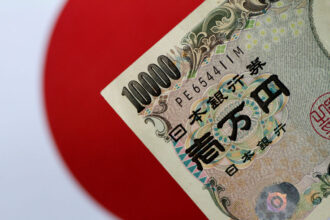For Ma Liang, a travel agent in Chengdu, China, bookings for overseas group travel are nearly full. “That’s because we’re barely offering any trips,” he said in an interview.
Demand for travel outside of China is so low that many services have been cut, from flight routes to excursions at the famous sights and shopping districts of cities like Paris, Rome, and New York—where throngs of Chinese used to roam in hordes, spending $255 billion in 2019, and becoming a lucrative cohort internationally.
All that changed during Covid, and it has yet to recover.
As of December, the capacity of flights leaving and entering China had reached just over half of the same period in 2019, according to flight analytics firm OAG Aviation Worldwide.
The routes themselves paint a striking picture. Domestic flights—or seats, to be precise—made up 92.6% last month while flights into or out of China made up only 7.4%, less than half the prepandemic level, according to OAG.
Analysts are beginning to be more realistic compared with their highly optimistic forecasts that Chinese leisure spending—including overseas travel—would skyrocket after Covid restrictions were dropped. Much of the pessimism now is based on the continued failure of consumer spending to rise.
“Non-domestic demand resumption remains uncertain,”
Morgan Stanley
analysts wrote last month. “It may take longer than expected for demand to recover from 70-80% of pre-Covid levels.”
Consultancy Oliver Wyman surveyed nearly 4,000 “affluent” Chinese and found that “many experienced international travelers from mainland China—namely, those who had already traveled internationally before the Covid-19 pandemic—are delaying their travel plans due to economic uncertainty.”
Retailers have struggled, especially luxury brands, which grew increasingly dependent on high-spending Chinese tourists over the course of the 2010s. In 2019, luxury spending by Chinese consumers represented about a third of the global market for high-end goods, according to Bain & Co. In 2023, that share had shrunk to just under a quarter.
That took a toll on top-line growth for the sector in the peak pandemic years, impacting everyone from industry giants like
LVMH Moët Hennessy Louis Vuitton
and
Kering
to smaller specialty companies, such as
Burberry Group
and
Canada Goose Holdings.
Many companies have started to note a tourism rebound, but the recovery is slow. On Jan. 25, LVMH said the company’s sales for the fourth quarter ended Dec. 31 to Chinese consumers in France were still about 30% less than in the same quarter in 2019, even though LVMH’s business in China is thriving.
“We’re not particularly concerned, neither pessimistic nor optimistic, but we don’t see the big busloads of Chinese customers coming in groups,” said LVMH CEO Bernard Arnault on a call with analysts.
Another factor—though smaller—seems to be personal exhaustion. China’s youth are experiencing an unprecedented unemployment crisis, which has given employers leverage to overwork employees.
Unemployed 28-year-old Yang Qi of Shanghai said two of her employed friends told her they both aren’t traveling because of sheer exhaustion from work. “They’re totally burned out,” she told Barron’s. And younger people who do travel aren’t spending the way they used to.
For the small number of Chinese who are traveling abroad, Asian countries are the main beneficiaries. Most outbound flights from China this month were to South Korea, but seat capacity was still 22% lower than in the same period in 2019.
Japan and Thailand were next, but their numbers were a fraction of prepandemic levels. Destinations like the U.S. and to one-time shopping paradises for wealthy Chinese like France and Italy now lack regular direct flights, according to the World Travel and Tourism Council.
Observers are waiting to see how numbers fare for this month’s Lunar New Year holiday, long known as the world’s largest annual human migration. While traditionally most people return home to feast together and visit family, an uptick in outbound travel was seen before the pandemic. Li Ying, 29, of Beijing, said financial considerations had influenced her decision not to return home for the holiday.
Governments have been scrambling to boost tourism. One issue: China’s passport and visa processing centers are overwhelmed—20 million Chinese passports have expired since 2020, according to travel management company BCD Travel China.
In November, in a rare move for a visa-stingy country like China, Beijing said it would allowing visa-free entry for nationals of France, Italy, Germany, Spain, the Netherlands, and Malaysia starting Dec. 1. Ireland and Switzerland were recently added to the list.
Malaysia reciprocated the visa-exemption policy for China. A similar mutual agreement was reached between China and Thailand, and China and Singapore said their reciprocal visa-free plan would begin sometime in early 2024.
Time will tell if the visa moves affect travel, but Chinese consumer sentiment has repeatedly disappointed over the past year, with large numbers saving for what they see as an uncertain future.
—Sabrina Escobar contributed to this article.
Write to [email protected]
Read the full article here










